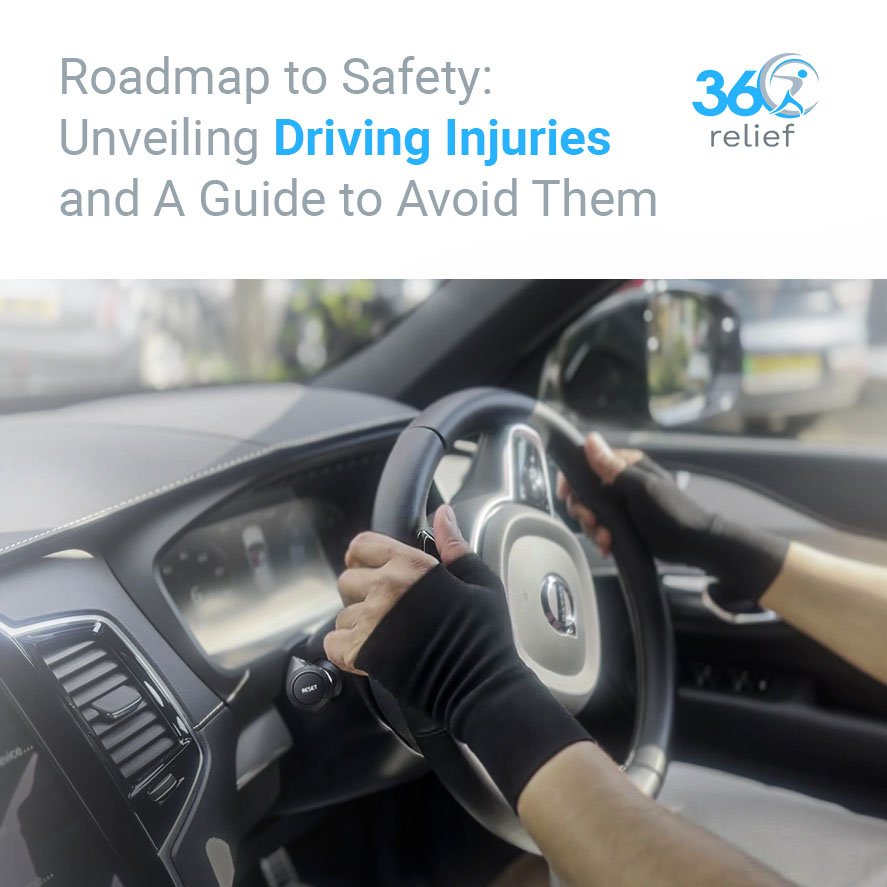
Flat 10% Off This Black Friday: Shop Smart, Save Big on Compression Socks and Other Support Braces
This Black Friday, take advantage of exclusive 10% savings on some of 360 Relief’s best-selling compression socks and support braces!

Do you want to hit the open road with confidence and comfort and avoid the hidden hazards that can arise during long journeys? While driving on long journeys during your jobs, expeditions, and for any other purpose, you may be susceptible to overuse injuries or discomfort. Prolonged sitting, lack of movement or stretching, inadequate breaks, repetitive motions, reduced concentrations, poor road conditions, and environmental conditions are notable factors contributing to injuries and discomforts during long journeys.
Whether you are a seasonal driver or tied in regular driving duties, overuse injuries can be possible in both cases. This article is a detailed account of the common overuse injuries to which drivers of long journeys or expeditions are more susceptible. Exploring these injuries along with their causes and symptoms, will help you avoid the risks of injuries.
At the same time, we have also arranged a safety roadmap with the art of ergonomic driving to take the wheel on this journey to a harmless and more enjoyable driving experience. So, buckle up, adjust your mirror, and start hitting on the road to a healthier lifestyle – where comfort is the destination and the path is delved with knowledge and prevention.
Table of Contents
ToggleProlonged driving or journeys on extended roads may cause several injuries or discomforts. Below are the common injuries drivers may encounter when driving for extended periods:
Long-journey driving requires sitting in a fixed position for hours. This prolonged sitting may put excessive strain on the ligaments or muscles of the lower back. The lack of support and movements may lead to bad posture, causing pain and other discomforts. The common symptoms of lower back pain may include sharp or dull pain, stiffness, and other discomfort based on the intensity of the injury.
Wearing lower back support braces is considered the most effective and easy way to treat or prevent the chances of lower back strains. Whenever you feel pain or other mentioned symptoms after a prolonged driving, consult your healthcare professionals and follow the possible treatment plans suggested by them.
Repeatedly checking blind spots, prolonged gripping on the steering, and holding your head in an awkward position may put excessive pressure on the neck and shoulder, causing neck and shoulder problems. You may feel stiffness, soreness, and pain in the upper shoulder and neck. Drivers may also feel other problems based on the intensity level of their duty.
Drivers are suggested to wear posture correctors to keep the upper back, shoulders, and neck in a straight or normal position. Thus, it helps avoid putting excessive pressure on these areas, helping reduce the chances of overuse injuries.
Carpal tunnel syndrome may also be considered a common problem finds in drivers who tend to drive for long hours. Drivers require constantly gripping the steering wheel with the wrist in a stretched or prolonged position. It may lead to the compression of the median nerve in the wrist. Consequently, it may result in carpal tunnel syndrome.
Whenever you feel pain, numbness, tingling sensation, or weakness around the wrist joint during or after driving, you may have developed carpal tunnel syndrome. You must consult your healthcare professionals to treat the symptoms of carpal tunnel syndrome. However, wearing wrist support braces helps reduce putting excessive pressure on the wrist joints, helping avoid the risk of carpal tunnel syndrome during long hours of driving.
Long hours of driving require sitting with repeated straightening and bending of the knee joints, causing knee problems. As well as this, poor seat position and putting excessive pressure on the knee joints may also cause knee pain and other discomforts.
Pain in the knee joints is the basic symptom you may feel. However, depending on your condition, you may also feel stiffness, aching, and other discomforts in the knee joints. Drivers who require to drive for extended periods are, sometimes, recommended to wear knee sleeves or knee support braces to avoid the chances of overuse knee injuries.
Driving is a duty that you performed while sitting in a fixed position. But, the duty requires the repeated actions of several body parts and the foot and ankles are among the commonly used parts. Drivers need hitting breaks, race, and clutches regularly. Performing these movements without proper positioning may cause discomfort and in some cases may result in serious injuries. Wearing foot support braces or ankle support braces helps reduce the impact of excessive pressure on the foot and ankles, helping keep your ankles and feet safe throughout the journey.
Everyone needs a smooth, secure, and enjoyable travelling or driving experience. When it comes to a profession, people want to perform it more securely to get a wonderful and injury-free driving experience. Below is a safety guide for drivers, proposed by experts, to avoid the chances of injuries on long journeys:
Prioritising ergonomic driving is recommended before hitting the road for an extended journey. It ensures optimal comfort and reduces strain or pressure on the body. Ensure that the driving seat is adjusted properly, you use the steering wheel accurately and are sitting in a proper position to keep your shoulder, neck, upper back, and lower back in a straight or normal position.
If you are on a long road journey or expedition, you are suggested to take frequent breaks. During break follow stretching exercises as well. It will help you avoid the impacts of overusing your body. Consequently, you will perform well without facing any overuse injuries and other discomforts.
Sitting on a fixed position or seat for a prolonged time may lead to discomfort and poor posture. it is advised to sit upright with relaxed shoulders and place your hands correctly on the steering wheel. You must also avoid leaning to the side or slouching as these actions may put excessive strain or pressure on the upper extremity, causing pain and other problems in the different body parts.
In order to minimise leg, ankle, and foot discomforts during long journeys, proper foot positioning is necessary. Ensure your feet reach the pedals comfortably and you must maintain a slight bend in the knees. In such a way, you can keep the lower extremity safe from overuse injuries.
Alertness and focus are crucial during driving as they keep you in a proper position during long hours of driving. Staying hydrated or improving your hydration level can help you maintain alertness and proper focus. Consequently, you keep yourself active and energetic, helping you perform well throughout your driving session.
Whether you are a seasonal driver or involved in regular driving duties on a daily basis, you may face overuse injuries in different body areas. However, maintaining proper positions, wearing safety equipment, and listening to your body help you keep yourself active and injury-free during hitting the roads for long expeditions or journeys. The above-mentioned causes and symptoms will surely help you avoid the actions that can put you to overuse injuries. As well as this, you must keep in mind all the safety measures, mentioned above, to have a safe and wonderful driving experience.

This Black Friday, take advantage of exclusive 10% savings on some of 360 Relief’s best-selling compression socks and support braces!

Everyday life includes walking up stairs, but knee discomfort can make this basic activity difficult. Walking up or down stairs

Cooking is a beloved activity for many, but for those struggling with knee pain, standing in the kitchen can quickly

We’ve all been there. On a ride in a car, for instance, to the country home for a weekend break

Gardening is enjoyable for many people and those who like tending to their lawns and plants usually find it therapeutic

Do you have a painful knee problem that takes you to physiotherapy…for an injury that hampers your daily living…your workout

Training can be very much associated with some pains and injuries that may be experienced by the trainers. As there

Office workers often spend hours seated at their desks, focusing on tasks while unknowingly putting their health at risk. The

Winter often brings more than just a change in weather; for many, it also means dealing with unexpected swelling in

Compression socks have become a critical tool for athletes across all sports. Whether you’re a marathon runner, cyclist, or weightlifter,

October marks the beginning of National Cholesterol Month in the UK, a time dedicated to raising awareness about cholesterol and

Overall, there is nothing to match the experience of watching musicians perform live in an outdoor concert in Glastonbury. However,

Today charity runs have gained popularity as a way of raising cash for a cause in the United Kingdom. From

Top 360 Relief Items for a Pain-Free Olympic Experience in Paris 2024 The Olympic Games are the most unique sporting

Wimbledon 2024 of tennis takes place annually at the prestigious All England Club and aims to provide tennis lovers with
Please enter your email to subscribe to our newsletter for exclusive offers and updates
Copyright © 2024 | 360 Relief Ltd | Sitemap

